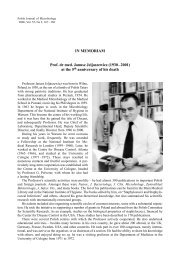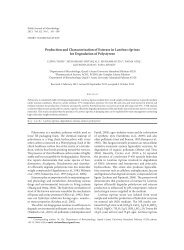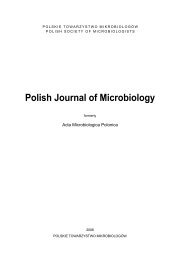No 3 - Polish Journal of Microbiology
No 3 - Polish Journal of Microbiology
No 3 - Polish Journal of Microbiology
Create successful ePaper yourself
Turn your PDF publications into a flip-book with our unique Google optimized e-Paper software.
<strong>Polish</strong> <strong>Journal</strong> <strong>of</strong> <strong>Microbiology</strong><br />
2011, Vol. 60, <strong>No</strong> 3, 223–228<br />
ORIGINAL PAPER<br />
Chitin-Glucan Complex Production by Schizophyllum commune<br />
Submerged Cultivation<br />
DZIANIS SMIRNOU*, MARTIN KRCMAR and EVA PROCHAZKOVA<br />
Introduction<br />
Chitin-glucan complex (CGC) is general name for<br />
a wide variety <strong>of</strong> biological copolymers composed <strong>of</strong><br />
chitin macromolecules with covalently linked β-Dglucan<br />
chains. The complex naturally occurs in the cellular<br />
walls <strong>of</strong> filamentous fungi, where it forms rigid<br />
micr<strong>of</strong>ibers that contribute cell wall mechanical strength.<br />
CGC can be extracted from fungal mycelium by various<br />
physiochemical and enzymatic methods, with the use<br />
<strong>of</strong> inorganic reagents, organic solvents, detergents, etc.<br />
(Ivshina, 2007). Traditionally CGC is recovered as an<br />
insoluble residue after mycelium successive treatments<br />
with alkali and acid. Fungal CGC is considered as an<br />
alternative source <strong>of</strong> chitin/chitosan (Wu et al., 2005;<br />
Teslenko and Woewodina, 1996) as well as a potent agent<br />
for application in medicine for wound-healing management<br />
(Teslenko and Woewodina 1996; Valentova et al.,<br />
2009), for improvement <strong>of</strong> desquamation process and<br />
xerosis reduction in diabetic patients (Quatresooz et al.,<br />
2009), for reduction <strong>of</strong> aortic fatty streak accumulation<br />
(Berecochea-Lopez et al., 2009), etc.<br />
Traditionally waste mycelium <strong>of</strong> Aspergillus niger<br />
from citric acid production is considered as an indus-<br />
CPN Ltd., Dolní Dobrouč, Czech Republic<br />
Received 10 March 2011, revised 5 May 2011, accepted 15 June 2011<br />
Abstract<br />
Chitin-glucan complex is a fungal origin copolymer that finds application in medicine and cosmetics. Traditionally, the mycelium <strong>of</strong><br />
Micromycetes is considered as an industrial chitin-glucan complex source. Basidiomycete Schizophyllum commune submerged cultivation for<br />
chitin-glucan complex production was studied. In different S. commune strains chitin-glucan complex composed 15.2 ± 0.4 to 30.2 ± 0.2%<br />
<strong>of</strong> mycelium dry weight. Optimized conditions for chitin-glucan complex production (nutrient medium composition in g/l: sucrose<br />
– 35, yeast extract – 4, Na 2 HPO 4 *12H 2 O – 2.5, MgSO 4 *7 H 2 O – 0.5; medium initial pH 6.5; aeration intensity 2 l <strong>of</strong> air per 1 l <strong>of</strong> medium;<br />
144 hours <strong>of</strong> cultivation) resulted in 3.5 ± 0.3 g/l complex yield. Redirection <strong>of</strong> fungal metabolism from exopolysaccharide synthesis to<br />
chitin-glucan complex accumulation was achieved most efficiently by aeration intensity increase. Chitin-glucan complex from S. commune<br />
had the structure <strong>of</strong> micr<strong>of</strong>ibers with diameter 1–2 µm, had water-swelling capacity <strong>of</strong> 18 g/g, and was composed <strong>of</strong> 16.63% chitin and<br />
83.37% glucan with a degree <strong>of</strong> chitin deacetylation <strong>of</strong> 26.9 %. S. commune submerged cultivation is a potent alternative to Micromycetes<br />
for industrial-scale chitin-glucan complex production.<br />
K e y w o r d s: Schizophyllum commune, chitin-glucan, optimized cultivation<br />
List <strong>of</strong> abbreviations: CGC – chitin-glucan complex, IPA – isopropanol, PDA – potato dextrose agar, rpm – rotations per minute,<br />
vvm – air volume per broth volume per minute, YE – yeast extract<br />
trial chitin(chitosan)-glucan complex source. There<br />
are several reports on other Micromycetes belonging to<br />
genus Ascomycota and Zygomycota utilization for CGC<br />
production (Wu et al., 2005; Teslenko and Woewodina<br />
1996). Basidiomycetes have been rarely considered as<br />
CGC producers, though they are capable <strong>of</strong> intensive<br />
growth in submerged culture as well. Schizophyllum<br />
commune is Basidiomycete used for β-(1,3;1,6)-Dglucan<br />
schizophyllan production. S. commune can be<br />
a promising culture for industrial scale CGC production<br />
if mycelium growth and CGC content in mycelium<br />
is increased and exopolysaccharide synthesis suppressed.<br />
The aim <strong>of</strong> the work was to characterize CGC<br />
from S. commune submerged mycelium and to study<br />
the possibility <strong>of</strong> fungal metabolism redirection from<br />
exopolysaccharide synthesis to CGC formation.<br />
Experimental<br />
Materials and Methods<br />
S. commune strains from different microorganism<br />
collections were used: F-795 (Czech Collection <strong>of</strong><br />
Microorganisms), 11223, 1024, 1025 and 1026 (German<br />
* Corresponding author: D. Smirnou, CPN Ltd., Dolní Dobrouč 401, 561 02 Dolní Dobrouč, Czech Republic; phone: + (420) 465 519 539;<br />
e-mail: smirnou@contipro.cz






